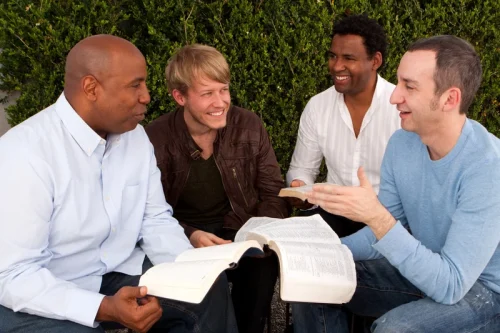
Here is a breakdown of the principles that match up with each step and how to practice them in a way that helps you create sustainable sobriety within the tenets of AA and NA. Each step centers around a phrase, many of them invoking the ideas of God or a “higher power” who guides the recovering addict in various facets of their journey into sobriety. This pamphlet answers many of the common questions people have about alcoholism and A.A. Once you arrive, you’ll meet with our staff and a doctor, who will assess your problems and help you through the withdrawal and detox portion of recovery. We’ll help make sure you stay healthy and safe during withdrawal, and keep you as comfortable as we can.


This time, he found himself face-to-face with a fellow sufferer who was succeeding. Bill rarely, if ever, introduced himself from the podium specifically as an alcoholic, and there is nothing in A.A. Conference-approved literature indicating how members should introduce themselves at A.A.
We have to confine our membership to alcoholics, and we have to confine our A.A. If we don’t stick to these principles, we shall almost surely collapse. During this hectic ten-year period, Dr. Bob devoted himself what does aa stand for alcohol to hospital care for alcoholics. Large numbers of alcoholics flocked to Akron to receive care at St. Thomas Hospital. He and the fellow staff member, the remarkable Sister Ignatia, cared for and brought A.A.
AA is, of course, heavily focused on principles of Christianity, but many of today’s groups have modernized the tenets to reflect a more diverse audience. Even so, the 12 Principles of AA have remained its central guiding influence. Many people suffering from alcoholism continue to find success in recovery by participating in AA’s program. AA meetings offer inmates a structured path toward sobriety inside correctional facilities or prisons.

As it is widely known, was founded in 1935 by Bill W. While each of these men had their own journey of recovery, it wasn’t until they met face to face that they realized the power of speaking with a “fellow sufferer” for achieving complete sobriety. AA is a non-judgmental space where all are welcome regardless of gender, race, ethnicity, or sexual orientation. There are no criteria or conditions set by the organization in order to become a member – all anyone needs is a desire to stop drinking alcohol. Love is empathy and compassion, and Step 8 asks you to make a list of everyone you’ve wronged in your journey to where you are now. You also have to be willing to make amends, which shows that you truly care for the people on your list.

It’s a request for donations to pay for things such as web hosting and any other expenses needed to keep group meetings going. The 12 steps from AA can be applied to many problems in life, and that includes living with someone with an addiction. While AA and NA members start by admitting their powerlessness over substance abuse, Al-Anon and Alateen members reflect on being powerless over the effects of those substances. It’s a subtle difference but one that has helped many Al-Anon members find peace again after struggling with someone in their lives who’s addicted. However, according to an early friend of A.A., the late Henrietta Seiberling, the expression dates back to meetings of A.A.’s forerunner, the Oxford Group Movement, which had its heyday in the early 1930s. Mrs. Seiberling, a nonalcoholic who had sought spiritual help in the Oxford Group meetings, was the person who introduced Bill W.
12 Keys offers a program of recovery at our center located along Florida’s waterfront. It’s a great setting to recover from drug or alcohol abuse and get the treatment you need. Some people want to attend just phone or online meetings. It may be hard to get to a face-to-face, or f2f, meeting, but it’s important to go at least on a regular basis.You do lose something when you’re not physically present with others during a meeting. Phone and online meetings can be useful when you can’t get to a meeting or in between your regular meetings, but for most people they cannot substitute all the time for f2f meetings.
Addiction is a lonely disease, and addiction is often called a self-centered disease. It makes people turn inward until everything is about their needs, their comfort, their fix. Phone meetings are essentially conference calls or group calls with a moderator who leads the meeting. Members mute their phones so extraneous noises don’t bother the group, then unmute their phones to share. Most meetings conclude with a prayer of some kind and a reminder to protect the anonymity of those at your meeting.
These meetings are a great way to gain a deeper understanding of what the book means and how others relate to it. Everywhere you go there are AA meetings where only women or men are allowed. You will also find many meetings that are gay, and some gay men’s meetings. This is to create safety when sharing about gender-specific issues. For instance, a member may be going through a heartbreaking divorce or having a problem in their marriage or another romantic relationship.
We do not impose our experience with problem drinking on others, but we do share it when we are asked to do so. We know our own sobriety depends on connecting with other alcoholics. A.A.’s Twelve Steps are a set of spiritual principles. When practiced as a way of life, they can expel the obsession to drink and enable the sufferer to recover from alcoholism. An increasing number of clinical investigators and scholars have studied the therapeutic elements of AA. Until the last half of this century, there were few if any treatments that seemed consistently effective in responding to the clinical needs of individuals who were abusing or dependent upon alcohol.